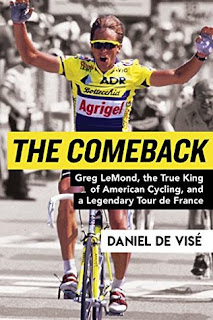Title/Author:
“The Comeback: Greg LeMond, the True King of American Cycling,
and a Legendary Tour de France” by Daniel de Visè
Tags:
Cycling, biography, history, performance enhancing drugs
Publish date:
June 5, 2018
Length:
432 pages
Rating:
5 of 5 stars (Outstanding)
Review:
Greg LeMond woke up
the American sporting public to the Tour de France with his upset victory in
the 1986 race. Three years later, after
his career nearly ended due to injuries suffered in a shooting accident during
a hunting trip, he again won the race by eight seconds over Frenchman Laurent
Fignon. The final stage of the race is the starting point of this terrific book
by Daniel de Visè.
While the book primarily
tells the story of LeMond’s life and career, the reader will learn much about
other prominent cycling athletes. The reader will learn why LeMond chose
cycling for his sport (he wanted to compete in sports where “I could accomplish
something myself without having to depend on others”), the sexual abuse he
suffered at the hands of a family member and how he became the voice of “clean”
racers when the doping culture of the sport became more prominent in the age of
erythropoietin (EPO) and later “mechanical doping” in which a small machine
would aid a cyclist with his speed.
Of course, the book delves
into the fall of Lance Armstrong and Greg’s interactions, both the good and the
bad, with the fallen star. It made for great reading, as it almost felt like a
soap opera, as Armstrong first was counting on LeMond’s advice on the life of a
professional cyclist, then later as the doping accusations became louder,
Armstrong nearly destroyed LeMond’s life, including the public revelation of Greg
being a victim of abuse. While much of
this material is available in other books, this account felt like a very
intimate and personal version. This was
just one example of the outstanding writing that was on display throughout the
book.
The story of Fignon is
just as compelling in this book as is LeMond’s as their lives seemed to move
along parallel paths. Like Greg, Laurent had his own demons and had to come
back from a serious injury. The 1989
Tour de France was the signature race of his comeback, just like LeMond, only
with a different result. The reader feels both LeMond’s joy and Fignon’s agony
in this result throughout the book as the results affected both men for the
rest of their lives.
The strategy of tour racing,
how teams work to ensure that their strongest rider will have a chance for
victory and the cutthroat nature of the sport are all on display in sections
about the races. The description of the peloton, or pack of riders, and what
goes on in that mass of bikes and humans, was very compelling and I enjoyed
learning just how important a role the peloton plays in the strategy for riders
during a race.
No matter the level of
knowledge or interest the reader has in cycling, this book is a must read for
all sports fans who love a good story of a classic comeback and of the
adventures of athletes, both “good” and “bad”.
I have been enjoying books on the sport and this one is certainly one of
the best.
I wish to thank Atlantic
Monthly Press for providing a copy of the book via NetGalley in exchange for an
honest review.
Book Format Read:
E-book (Kindle)
Buying
Links:

No comments:
Post a Comment